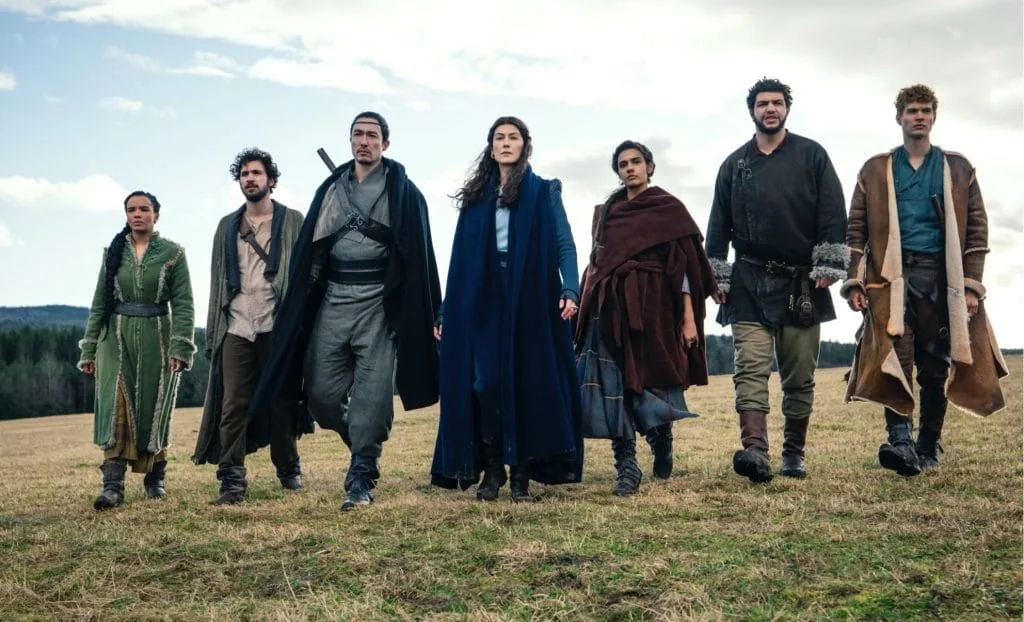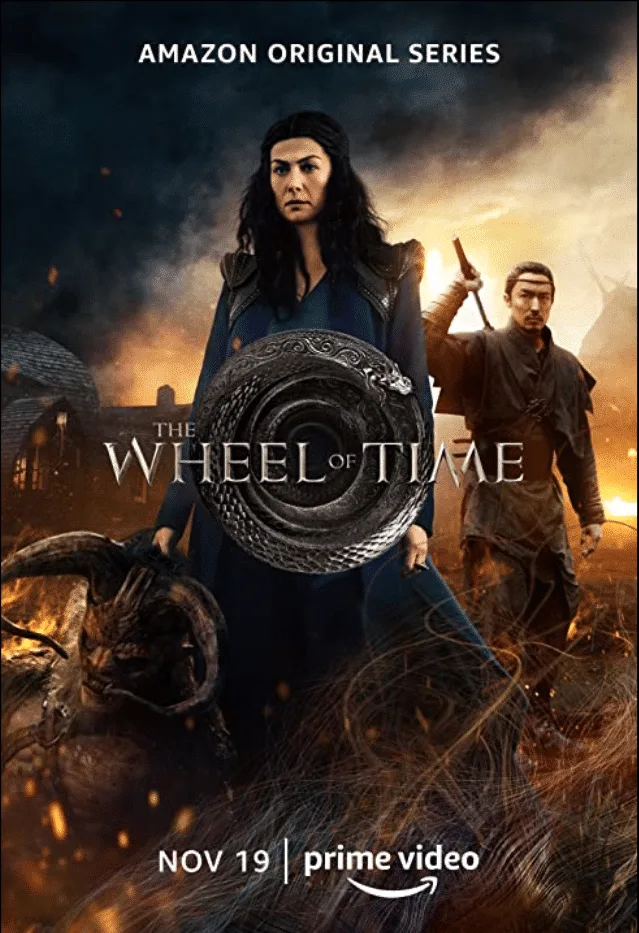
Amazon is not an organisation known for its tight budget, so it was no surprise to find out that its recent exclusive TV series The Wheel of Time – according to some sources – has cost an eye-watering $80 million to make. Based on a series of so-called ‘high fantasy’ novels by author Robert Jordan, some might suggest that these were never a good candidate for adaptation at all. With a vast array of characters (numbering in the thousands!) and a kind of world-building which apparently hovers between impressive and derivative, it stands on the brink of alienating Jordan fans, and not winning over anyone else, who might well see The Wheel of Time as Game of Thrones without the fun. It turns out that yet another world of monsters and corsets isn’t as diverting as you’d hope.
For the record, I’m in the latter camp; I haven’t read the Jordan novels as they sound horribly overbearing to me, and the moniker ‘high fantasy’ almost always makes me think of the unpopular kids who tried to choose their own nickname. What’s high about this, exactly? The ‘high’ aspect is, apparently, meant to designate all the monsters and corsets as somehow speaking the truth to power, a symbolic slab of world-building which calls to higher, deeply human truths. Appreciably, the term may be more the work of fans than the novelist, and in many ways this series wasn’t really intended for me, but it still begs the question: what is the higher truth here? What wisdom does The Wheel of Time endow which sets it apart from the rest?
Here’s what I’ve seen, by seven tedious episodes in and with one to go. There’s a journey of some kind. Tick. There’s the suggestion that, through fate – tick – five young people in a remote village could be the ‘Dragon incarnate’, which means that they will at some point in their near futures have the choice to either make or break the world as they know it. We don’t know which of them is the Dragon, and sadly it seems that the term ‘Dragon’ is being used symbolically here, which has so far deprived the series of a bloody good, great big monster to quell the tedium; even the final season of Game of Thrones, shorn of plot, at least had a real, city-felling dragon. Hope is now dwindling for this in The Wheel of Time. But anyway, a mysterious magician – tick – has ridden into the village promising to help guide these young people – even if she can’t tell who, exactly, is the fated one out of the five of them – on an Unexpected Journey. Tick. This journey is prompted by a heinous attack on their sleepy hamlet by some critters called trollocks, sorry, trollocs, NOT orcs, and stop laughing at the back, Brits. So off they go, getting split up, getting back together again, and that has taken no insignificant amount of time.
What can possibly justify this effort? Rather than a higher truth, what this looks like is a basic re-tread of Lord of the Rings – and that’s one thing which could quite easily be done without.
Fantasy writers so often seem to settle into the same pattern, the same clichés, and I say that as a (primarily) horror fan who has lived through the found footage era. But, even that churned up some more variety than a hell of a lot of fantasy, high or bloody otherwise. Tolkien probably never intended to spawn a thousand bedroom writing projects from bearded and/or braided people who often hold his work in higher esteem than any religion, but he has, and he’s established some by-now incredibly worn trammels which no one seems to really question, or even mind all the repetition. The fantasy genre so often seems to present a kind of Medieval Europe with funky add-ons, hanging onto a predictable array of accessories – buxom wenches, tyrannical knights, sword battles, cloaks, awkward afternoons at the tavern, a pre-technology hearthside or two – but augmenting them, perhaps taking the rather more historically-dubious claims of wyrms and witchcraft from real manuscripts and making them flesh. Medieval Europe was Christian, and the hangover from that is a long one: there’s usually some diabolical figure of chaos who threatens the world, like that lad from the Bible, and some mortal force for good to push back – ditto.
In many ways, fine, there’s space for this kind of storytelling, it’s as old as the hills in fact, and in many ways this forges an interesting link between the hazy world of early European history and a modern, limitless filmmaking which can paint something really grand out of all that. Certain series exceed these trammels because the character writing is so good – think The Witcher. But: if this re-treading is happening over and over, with newer incarnations each seeming successively rinsed of novelty and characterisation, then it’s time for a change. The Wheel of Time is guilty on both fronts of this weak, derivative storytelling.

The first issue is that it is practically impossible to care about these would-be Dragons. They are personality free zones, collapsing under the weight of their names, which each read like a bad hand at Scrabble – with the exception of the unusually pedestrian name of Matt, or ‘Mat’ for one of them, but (spoiler) he seems to be a bit of a bad lot, as you’d expect with such a common name. Matt? That’s a name from the local paper, if ever I heard one, whether you drop a ‘t’ or not. If in doubt when naming, bang in a few vowels; that makes names more exotic, apparently. Each of these people seems to be dressed exclusively in ethically-sourced cotton, they’re all wild-eyed with a lack of understanding, and they each do a manageable number of stupid things per episode as they proceed on their journey. Ostensibly there to guide them to what look an awful lot like the Oblivion Gates from the Elder Scrolls is Moraine Damodred, a member of the equally voweltastic Aes Sidai, which is a female-only magic organisation. Yes, it’s progressive, as only women can really do magic, but ‘progressive’ here seems to mean ‘what we give, we take away’, which isn’t really all that progressive at all.
For starters: the magic itself is a bit hit and miss. It’s rare, mostly insipid and bloody dull to watch when it is there. It seems to entail a hell of a lot of effort to generate a few wisps of cobwebby Forces, or do some suitably feminine healing: any more than this and the spellcaster seems utterly incapacitated, just like a fainting maiden who has over-exerted herself by looking out of a window or trying to dress herself, or something. The other, younger women, when not fighting with every bit as much physical strength as the bigger, heavier, more muscular males in the story, natch, are also capable of this magic, but again – it’s hit and miss. On a similarly progressive note, clearly a lot of time and care has been put into selecting an ethnically-diverse cast here, and that’s fine: there’s no sense or purpose in quibbling over the ethnic makeup of a society in a world where wispy magic exists.
But what is given, is taken away: why, then, do the only Irish accents in this belong to a band of itinerant tinkers? Is that not a stereotype, one which a large proportion of Irish people would like to query? Some stereotypes, some omissions, some creative decisions are more resilient than others, and they’re left in there, because deeply cosmetic priorities are endemic at this stage. Similarly, the Aes Sidai aren’t really allowed to fraternise with menfolk unless it’s in the form of the woman’s personal steward – think Tails scampering after Sonic – but they are allowed to have sexual-ish relationships with other women; we get to see a bit of that. This is progressive, see, but then they seem to rely on their stewards to travel anywhere; admittedly, the resilience of da patriarchy is openly discussed in the script, but it’s still in there, even in this particular fantasy, and unaddressed in any depth. It seems relevant that the Aes Sidai ‘cannot lie’, but they are free to bend the truth; that’s how the whole series to date feels; this is an attempt to do something with due diligence which nonetheless relies on twisting that into a recognisable form, whenever it’s expedient.
Rosamund Pike, saddled here with the lead role and the task of précising an unwieldy amount of back story, simply cannot do her usual, metaphorical magic (I would also question how the hell something can cost millions of dollars, but a bad wig still look like a bad wig; now this is the tale as old as time). Her presence on-screen to some extent helps to corral some kind of purpose and personality out of her young charges, but she’s not infallible, and her character often looks as perplexed by their torpor as many of us must surely be. Once you’ve zoned out of the pretty scenery, there is almost nothing of quality here, and what’s left is just a slab of Amazon TV filler, both overly busy and empty, a paragon of more money than sense.
The Wheel of Time is a plodding, derivative and toe-curling fantasy series which will win the novels no new devotees, and may put off a few existing fans, though Serious Fans will probably just enjoy seeing characters and places from their favourite books rendered in 3D. Good for them.
